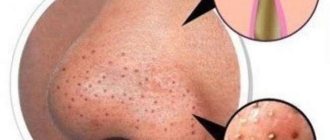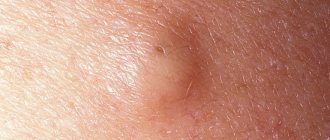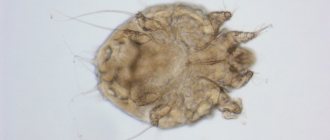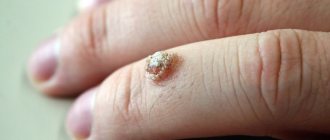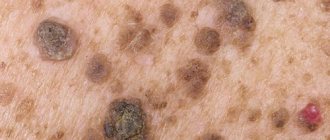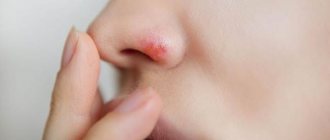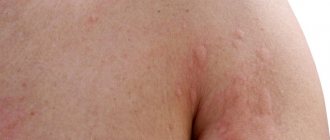The skin of the hands is often exposed to negative external influences. Due to dry or cold air, hard water, and detergents, it can peel and burst. Cracks and wounds appear. Since hands are constantly used by a person in any activity, they do not heal for a long time, they hurt and become inflamed. And women are also caused psychological discomfort, because cracks on the fingers look ugly. To avoid problems, you need to understand the causes of their occurrence and know how to treat them.
Causes of cracks
A very small number of people carefully care for the skin of their hands; the majority are lazy or do not consider it necessary, especially for men who engage in physical labor. They think it’s funny to put cream on your hands at night, considering it the prerogative of women. But the skin is a protective barrier against viruses and infections, and it is the hands that are exposed to many phenomena unfavorable to the skin: temperature changes, unprotected contacts with household chemicals, working in the garden or garden, metal or building materials without gloves.
Builders, mechanics, welders, gardeners cannot boast of well-groomed hands. Their palms are rough, with dry skin, insensitive and covered with calluses, abrasions and cracks on the fingers, the causes and treatment of which depend on many factors leading to dry skin.
External factors
- Temperature and water. Do you walk in frosty, windy weather without mittens or mittens? Are you in contact with cold or, on the contrary, very hot water? Get ready for the skin to become dry, and then cracks are not far away. The cold is especially destructive - the blood vessels narrow, and the fingers do not receive sufficient nutrients and moisture.
- Household chemicals. Not all home care products contain protective ingredients. Often the skin cracks when in contact with detergents, plant fertilizers or building mixtures: cement, wallpaper glue, paints and varnishes. Therefore, it is necessary to protect your hands from aggressive chemical compounds that corrode the skin and dry it out. Are you cleaning, gardening or doing renovations? Wear gloves!
- Mechanical damage. The hands of people involved in heavy physical labor are often far from ideal. Neglect of protective agents leads to microtraumas of the skin, the water balance is disturbed, the skin dries and cracks.
Internal factors (diseases)
If you exclude external factors, then diseases may be possible causes of cracks. In this case, you need to consult a doctor. Start with a visit to a therapist, who, having ruled out common diseases, will refer you to specialized specialists: a dermatologist, endocrinologist, gastroenterologist.
Diseases that contribute to the appearance of cracks are as follows.
- Skin diseases. Fungus, eczema, psoriasis.
- Improper metabolism. Diabetes, thyroid problems, old age, hormonal changes.
- Avitaminosis. Lack of vitamins: A, B, E, Omega-3 and magnesium.
- Digestive tract problems. Gastritis, cholecystitis.
As a result of these ailments, cracks may appear on the phalanges, between the fingers, in the nail area, or even on the palms. The use of emollient creams and ointments will temporarily alleviate the condition, but will not solve the problem until treatment for the underlying disease is prescribed.
What causes the skin on your fingers to crack?
Cracked skin on your fingers can be a problem all year round, but it occurs more often in winter, especially if you live in a harsh continental climate.
Causes of cracking finger skin:
- Direct skin contact with detergents and cleaning products. Try cleaning the bathtub with Domestos or Comet without using gloves - cracks are guaranteed. Household chemicals contain aggressive substances and surfactants, which upon contact with the skin kill all microflora on it.
- Frequent hand washing with regular or laundry soap. Due to dryness, the skin becomes thin and begins to crack.
- Cold wind, especially if your hands are wet. This is where the expression “chapped hands” comes from. This is often encountered by lovers of mitts - fingerless gloves in which only the palm and the back of the hand are protected from the cold.
- Nail coating with gel polish, biogel, acrylic. Your fingertips may peel if you often get manicures or go to an unprofessional manicurist. When applying/removing gel polish and other coatings, the master must protect the skin around the nails by applying a rich cream or special oil to it. The skin on the fingertips can crack especially severely after the coating removal procedure, when the nails are covered with a solvent liquid for 5-10 minutes and tight caps are put on so that the product does not evaporate. In this case, the skin suffers greatly.
These factors disrupt the skin's protective barrier and cause damage to the outer lipid layer of the epidermis. Skin deprived of a protective fat layer quickly dries out, becomes thinner, loses elasticity, and cracks easily.
Drug treatment of cracks
Small and shallow cracks that appear as a result of external factors can be treated relatively quickly; it is enough to protect them from accidental damage and use anti-inflammatory ointments and emollient creams. Deep and long-lasting cracks require a serious approach and the use of deep penetration wound healing ointments.
Complex means
If the cracks do not heal for a long time, consult a doctor; they may be caused by a chronic disease. In this case, complex treatment will be prescribed using medications for the underlying disease and ointments for wound healing.
Antibacterial, corticosteroid, antihistamine, or metabolism-increasing medications can only be prescribed by a doctor. Do not self-medicate under any circumstances.
Drugs for symptomatic treatment
Creams and ointments:
- Bioderma. Therapeutic cosmetics aimed at eliminating skin diseases;
- Green pharmacy. Chamomile or aloe. Hand creams with a moisturizing and softening effect;
- Levomekol. Has anti-inflammatory and antimicrobial effects;
- Rescuer or Guardian. Universal balms with vegetable oils effectively disinfect, nourish and heal. Apply in a thick layer;
- Medical glue BF-6. An excellent antiseptic and wound healing drug. Apply a thin layer to the crack, on which a strong film is formed, tightening the edges and preventing infection.
How to treat chapped skin in a child
Usually, under the influence of external factors, the skin on the hands of an adult cracks. But this problem also occurs in children. If your child's fingers are very peeling, you need to see a doctor and get examined. After all, the cause of this may be dermatitis, allergies, vitamin deficiency, or fungal infection. Therefore, treatment must be prescribed by a doctor.
But if the problem has just appeared, you can try to deal with it yourself. It is necessary to monitor the level of air humidity in the nursery, do wet cleaning more often, and ventilate the room. Remove allergens, synthetic clothing, change cosmetics to hypoallergenic ones. It is recommended to add decoctions of string, chamomile, and calendula to the baby’s bathing water.
It is necessary to monitor nutrition, give babies hypoallergenic formulas, and when breastfeeding, mothers should avoid harmful foods. For older children, it is important to have a sufficient intake of vitamins and minerals from food. Dry baby skin can be lubricated with soft cosmetic milk for sensitive skin or Bepanten cream.
Traditional medicine recipes
If cracks in the fingers are formed as a result of internal factors, then the use of folk remedies can be used as an additional treatment.
If external phenomena are to blame, then we can limit ourselves exclusively to traditional medicine.
The main principle of treatment is to constantly moisturize the skin of the hands and saturate the body with vitamins and microelements. Warm baths and compresses are very useful - they steam the skin, open the pores and better absorb medicinal components. After the procedures, be sure to lubricate your hands with a rich, nourishing cream.
Potato starch bath
Dissolve a teaspoon of starch in a small amount of cold water and add two glasses of hot water. Use as a bath for dry hands for at least 10 minutes. After the procedure, do not wash off the starch, pat dry and apply moisturizer.
Bath from Hercules
Cook oatmeal from regular Hercules flakes, cool to a comfortable temperature and add a spoonful of honey and a little olive or sunflower oil. Dip your fingers into the porridge and hold for at least 20 minutes. Rinse with cool water and use hand cream.
Salty hot bath
A very simple and effective method of treatment. Dissolve a teaspoon of salt and soda in a glass of hot water. You can use sea salt or regular table salt. Dip your fingers into the brine and hold until it cools completely. Hot water softens the skin, and salt and soda penetrate deeply into the wound, disinfect and relieve inflammation.
After the procedure, lubricate your hands with healing natural ointment made from egg yolk, honey and vegetable oil.
Milk therapy
- With bread. Soak a piece of white bread in warm milk, dip your hands in it and hold until it cools completely.
- With potato. Open the potato and mash it into a puree, add warm milk. Apply the resulting mixture to the wounds and wrap in cellophane for half an hour.
Calendula decoction
Calendula has a wound-healing and restorative effect. To prepare a decoction, add 20 grams of dry calendula to a liter of water and boil over low heat for 10 minutes. Cool to a comfortable temperature and keep your hands for 30 minutes. There is no need to rinse off the broth after the bath.
Nettle and marigold
Mix a handful of dry nettle leaves with a small amount of marigolds (calendula petals), approximately in a ratio of 2 to 1, pour a glass of boiling water and leave for at least 10-15 minutes. Immerse your hands in the infusion and hold until it cools completely.
Honey compress
Crush a couple of acetylsalicylic acid (aspirin) tablets into powder, mix with honey and any vegetable oil. Apply generously to cracks and wear plastic or rubber gloves.
Wax thimbles
Melt the beeswax in a water bath and cool until warm. Dip your cracked fingers into it and wait until it hardens completely. It is advisable to do the procedure at night. To avoid damaging the thimble, wear light cotton gloves.
The wax “seals” and heals the wound. Church candles are made from it, so you can use a piece of a candle. Smell it, it should smell like honey and is usually dark in color.
Mumiyo
Buy mummy in tablets at the pharmacy and dissolve it with a small amount of water. Make baths or compresses, and in just a few days the wounds will heal.
Grandma's secrets
Our great-great-grandmothers could not imagine their lives without vegetable gardens, and protective gloves had not yet been invented in those days. Therefore, problems with the skin of the hands were constantly encountered. What herbs can help soften, moisturize and heal? We list the most popular plants:
- series;
- nettle;
- yarrow;
- burdock;
- St. John's wort;
- Linden;
- shepherd's purse.
These herbs have antiseptic, anti-inflammatory, peeling and restorative effects. They can be purchased at a pharmacy and brewed to make baths, like tea. Moreover, you can use them separately or make a mix of herbs, mixing them in equal parts.
Useful tips
People usually don’t even think about the fact that they can wash their hands incorrectly. However, there are nuances here too.
- For these purposes, it is necessary to use only warm water: cold or hot water damages the skin.
- It is advisable to use liquid soap with a neutral acidity level: this will prevent irritation. Usually it dries out the skin. Extracts of medicinal plants included in the soap have a moisturizing and soothing effect, and therefore prevent the appearance of dryness and cracks.
- After washing, dry your hands thoroughly with a terry towel. Don't forget about the areas between the fingers. The paradox is that excessive exposure to moisture also leads to dry skin.
- Lubricate your hands with moisturizer.
Prevention
Cracks on your fingers can be avoided if you use simple preventive measures:
- Protective gloves. When cleaning your home using detergents, making repairs, or working with plants, be sure to wear gloves. Perhaps their use will be unusual and inconvenient at first, but beautiful, well-groomed, and most importantly, healthy hands are more important. In cold weather, wear gloves, as frost and wind dry out the skin of your hands and contribute to the formation of cracks.
- Chronic diseases. Visit your doctor promptly when the first signs of illness appear and do not delay treatment.
- Balanced diet. If there is a lack of nutrients or microelements that come from food, drink vitamin complexes regularly. Try to diversify your menu, give up nicotine and alcohol.
- Moisturizers. If possible, use hand cream several times a day, especially after contact with water.
Nutrition for healing cracks in hands
Proper and healthy nutrition helps get rid of cracks and prevent their occurrence.
Its essence is to fill the body with necessary substances. Therefore, the diet during the treatment period consists of foods rich in minerals and vitamins. Vitamins A, E and B products or complexes should be consumed.
In addition, the body requires large amounts of Omega 3 fats, found in fatty fish, fish oil and other seafood.
You should never forget about your hands. They require care and respect. Regardless of the conditions in which you work, safety measures must always be taken.
Cracks are the result of skin diseases or neglect of hygiene and lack of proper care. Cracks should be dealt with as early as possible, and it is better to prevent their occurrence, which folk remedies will help with.
Otherwise, due to damage, it will become impossible to perform some usual actions due to the discomfort experienced. For preventive purposes, the products can be used 1 or 2 times a week, this will keep your hands in perfect order.
Nutrition and lifestyle
When careful care is carried out and all precautions are observed, but your hands become dry, the reason may be a lack of vitamins. Dry, rough skin is a sign of nicotinic acid deficiency in the body. Vitamin PP is present in cereals, beans and lean fish. Flaky skin covered with pustules indicates a lack of retinol and carotene. A lack of vitamin A is indicated by the presence of dark spots on the hands. This element is present in pumpkin, carrots, tomatoes, egg yolk, and also in all types of liver. Skin that has lost its elasticity and looks sluggish needs vitamin E.
